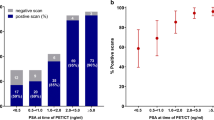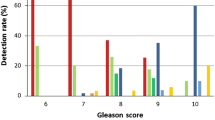Abstract
Purpose
Prostate-specific membrane antigen (PSMA) PET/CT is increasingly used in patients with biochemical recurrence post prostatectomy to detect local recurrence and metastatic disease at low PSA levels. The aim of this study was to assess patterns of disease detection, predictive factors and safety using [18F]DCFPyL PET/CT versus diagnostic CT in patients being considered for salvage radiotherapy with biochemical recurrence post prostatectomy.
Methods
We conducted a prospective trial recruiting 100 patients with detectable PSA post prostatectomy (PSA 0.2–2.0 ng/mL) and referred for salvage radiotherapy from August 2018 to July 2020. All patients underwent a PSMA PET/CT using the [18F]DCFPyL tracer and a diagnostic CT. The detection rates of [18F]DCFPyL PET/CT vs diagnostic CT were compared and patterns of disease are reported. Clinical patient and tumour characteristics were analysed for predictive utility. Thirty-day post-scan safety is reported.
Results
Of 100 patients recruited, 98 were suitable for analysis with a median PSA of 0.32 ng/mL. [18F]DCFPyL PET/CT was positive 46.4% and equivocal 5.2%, compared to 15.5% positivity for diagnostic CT. Local recurrence was detected on [18F]DCFPyL PET/CT in 28.5%, nodal disease in 27.5% and bony metastases in 6.1% of patients. Both ISUP grade group (p < 0.001) and pre-scan PSA (p = 0.029) were significant predictors of [18F]DCFPyL PET/CT positivity, and logistic regression generated probabilities combining the two showed improved prediction rates. No significant safety events were reported post [18F]DCFPyL administration.
Conclusions
[18F]DCFPyL PET/CT increases detection of disease in patients with biochemical recurrence post prostatectomy compared to diagnostic CT. Patients being considered for salvage radiotherapy with a PSA >0.2 ng/mL should be considered for [18F]DCFPyL PET/CT scan.
Trial registration
Australian New Zealand Clinical Trials Registry Number: ACTRN12618001530213 (http://www.anzctr.org.au/Trial/Registration/TrialReview.aspx?id=375932&isReview=true)




Similar content being viewed by others
Data availability
Not applicable.
Code availability
Not applicable.
References
Thompson IM, Valicenti RK, Albertsen P, Davis BJ, Goldenberg SL, Hahn C, et al. Adjuvant and salvage radiotherapy after prostatectomy: AUA/ASTRO guideline. J Urol. 2013;190:441–9. https://doi.org/10.1016/j.juro.2013.05.032.
Tendulkar RD, Agrawal S, Gao T, Efstathiou JA, Pisansky TM, Michalski JM, et al. Contemporary update of a multi-institutional predictive nomogram for salvage radiotherapy after radical prostatectomy. J Clin Oncol. 2016;34:3648–54. https://doi.org/10.1200/jco.2016.67.9647.
Vargas HA, Martin-Malburet AG, Takeda T, Corradi RB, Eastham J, Wibmer A, et al. Localizing sites of disease in patients with rising serum prostate-specific antigen up to 1ng/ml following prostatectomy: How much information can conventional imaging provide? Urol Oncol. 2016;34:482 e5–e10. https://doi.org/10.1016/j.urolonc.2016.05.026.
Ananias HJ, van den Heuvel MC, Helfrich W, de Jong IJ. Expression of the gastrin-releasing peptide receptor, the prostate stem cell antigen and the prostate-specific membrane antigen in lymph node and bone metastases of prostate cancer. Prostate. 2009;69:1101–8. https://doi.org/10.1002/pros.20957.
Minner S, Wittmer C, Graefen M, Salomon G, Steuber T, Haese A, et al. High level PSMA expression is associated with early PSA recurrence in surgically treated prostate cancer. Prostate. 2011;71:281–8. https://doi.org/10.1002/pros.21241.
Perera M, Papa N, Roberts M, Williams M, Udovicich C, Vela I, et al. Gallium-68 prostate-specific membrane antigen positron emission tomography in advanced prostate cancer-updated diagnostic utility, sensitivity, specificity, and distribution of prostate-specific membrane antigen-avid lesions: a systematic review and meta-analysis. Eur Urol. 2020;77:403–17. https://doi.org/10.1016/j.eururo.2019.01.049.
Dietlein F, Kobe C, Neubauer S, Schmidt M, Stockter S, Fischer T, et al. PSA-stratified performance of 18F- and 68Ga-PSMA PET in patients with biochemical recurrence of prostate cancer. J Nucl Med. 2017;58:947–52. https://doi.org/10.2967/jnumed.116.185538.
Lindenberg L, Mena E, Turkbey B, Shih JH, Reese SE, Harmon SA, et al. Evaluating biochemically recurrent prostate cancer: histologic validation of (18)F-DCFPyL PET/CT with comparison to multiparametric MRI. Radiology. 2020;296:564–72. https://doi.org/10.1148/radiol.2020192018.
Hofman MS, Iravani A, Nzenza T, Murphy DG. Advances in urologic imaging: prostate-specific membrane antigen ligand PET imaging. Urol Clin N Am. 2018;45:503–24. https://doi.org/10.1016/j.ucl.2018.03.016.
Rowe SP, Gorin MA, Pomper MG. Imaging of prostate-specific membrane antigen using [(18)F]DCFPyL. PET Clin. 2017;12:289–96. https://doi.org/10.1016/j.cpet.2017.02.006.
Perry E, Talwar A, Taubman K, Ng M, Wong LM, Booth R, et al. [(18)F]DCFPyL PET/CT in detection and localization of recurrent prostate cancer following prostatectomy including low PSA < 0.5 ng/mL. Eur J Nucl Med Mol Imaging. 2021. https://doi.org/10.1007/s00259-020-05143-9.
IBM Corp. IBM SPSS statistics for windows, version 26.0. Armonk: IBM Corp; 2019.
R Core Team. R: a language and environment for statistical computing. Vienna, Austria: R Foundation for statistical Computing; 2020.
Sing T, Sander O, Beerenwinkel N, Lengauer T. ROCR: visualizing classifier performance in R. Bioinformatics. 2005;21:78–81.
Robin X, Turck N, Hainard A, Tiberti N, Lisacek F, Sanchez J-C, et al. pROC: an open-source package for R and S+ to analyze and compare ROC curves. BMC Bioinformatics. 2011;12:77.
Perera M, Papa N, Roberts M, Williams M, Udovicich C, Vela I, et al. Gallium-68 prostate-specific membrane antigen positron emission tomography in advanced prostate cancer-updated diagnostic utility, sensitivity, specificity, and distribution of prostate-specific membrane antigen-avid lesions: a systematic review and meta-analysis. Eur Urol. 2019. https://doi.org/10.1016/j.eururo.2019.01.049.
Liu W, Zukotynski K, Emmett L, Chung HT, Chung P, Wolfson R, et al. A prospective study of 18F-DCFPyL PSMA PET/CT restaging in recurrent prostate cancer following primary external beam radiotherapy or brachytherapy. Int J Radiat Oncol Biol Phys. 2020;106:546–55. https://doi.org/10.1016/j.ijrobp.2019.11.001.
Jansen BHE, Jansen RW, Wondergem M, Srbljin S, de Klerk JMH, Lissenberg-Witte BI, et al. Lesion detection and interobserver agreement with advanced image reconstruction for (18)F-DCFPyL PET/CT in patients with biochemically recurrent prostate cancer. J Nucl Med. 2020;61:210–6. https://doi.org/10.2967/jnumed.118.222513.
Wondergem M, Jansen BHE, van der Zant FM, van der Sluis TM, Knol RJJ, van Kalmthout LWM, et al. Early lesion detection with (18)F-DCFPyL PET/CT in 248 patients with biochemically recurrent prostate cancer. Eur J Nucl Med Mol Imaging. 2019;46:1911–8. https://doi.org/10.1007/s00259-019-04385-6.
Rowe SP, Campbell SP, Mana-Ay M, Szabo Z, Allaf ME, Pienta KJ, et al. Prospective evaluation of PSMA-targeted (18)F-DCFPyL PET/CT in men with biochemical failure after radical prostatectomy for prostate cancer. J Nucl Med. 2020;61:58–61. https://doi.org/10.2967/jnumed.119.226514.
Rousseau E, Wilson D, Lacroix-Poisson F, Krauze A, Chi K, Gleave M, et al. A prospective study on (18)F-DCFPyL PSMA PET/CT imaging in biochemical recurrence of prostate cancer. J Nucl Med. 2019;60:1587–93. https://doi.org/10.2967/jnumed.119.226381.
Song H, Harrison C, Duan H, Guja K, Hatami N, Franc BL, et al. Prospective evaluation of (18)F-DCFPyL PET/CT in biochemically recurrent prostate cancer in an academic center: a focus on disease localization and changes in management. J Nucl Med. 2020;61:546–51. https://doi.org/10.2967/jnumed.119.231654.
Emmett L, Tang R, Nandurkar R, Hruby G, Roach P, Watts JA, et al. 3-year freedom from progression after (68)Ga-PSMA PET/CT-triaged management in men with biochemical recurrence after radical prostatectomy: results of a prospective multicenter trial. J Nucl Med. 2020;61:866–72. https://doi.org/10.2967/jnumed.119.235028.
Dietlein M, Kobe C, Kuhnert G, Stockter S, Fischer T, Schomacker K, et al. Comparison of [(18)F]DCFPyL and [ (68)Ga]Ga-PSMA-HBED-CC for PSMA-PET imaging in patients with relapsed prostate cancer. Mol Imaging Biol. 2015;17:575–84. https://doi.org/10.1007/s11307-015-0866-0.
Eiber M, Kroenke M, Wurzer A, Ulbrich L, Jooss L, Maurer T, et al. (18)F-rhPSMA-7 PET for the detection of biochemical recurrence of prostate cancer after radical prostatectomy. J Nucl Med. 2020;61:696–701. https://doi.org/10.2967/jnumed.119.234914.
Giesel FL, Knorr K, Spohn F, Will L, Maurer T, Flechsig P, et al. Detection efficacy of (18)F-PSMA-1007 PET/CT in 251 patients with biochemical recurrence of prostate cancer after radical prostatectomy. J Nucl Med. 2019;60:362–8. https://doi.org/10.2967/jnumed.118.212233.
Boreta L, Gadzinski AJ, Wu SY, Xu M, Greene K, Quanstrom K, et al. Location of recurrence by gallium-68 PSMA-11 PET scan in prostate cancer patients eligible for salvage radiotherapy. Urology. 2019;129:165–71. https://doi.org/10.1016/j.urology.2018.12.055.
Roach PJ, Francis R, Emmett L, Hsiao E, Kneebone A, Hruby G, et al. The impact of (68)Ga-PSMA PET/CT on management intent in prostate cancer: results of an Australian prospective multicenter study. J Nucl Med. 2018;59:82–8. https://doi.org/10.2967/jnumed.117.197160.
Michalski JM, Lawton C, El Naqa I, Ritter M, O'Meara E, Seider MJ, et al. Development of RTOG consensus guidelines for the definition of the clinical target volume for postoperative conformal radiation therapy for prostate cancer. Int J Radiat Oncol Biol Phys. 2010;76:361–8. https://doi.org/10.1016/j.ijrobp.2009.02.006.
Pollack A, Karrison TG, Balogh AG Jr, Low D, Bruner DW, Wefel JS, et al. Short term androgen deprivation therapy without or with pelvic lymph node treatment added to prostate bed only salvage radiotherapy: the NRG oncology/RTOG 0534 SPPORT trial. Int J Radiat Oncol Biol Phys. 2018;102.
Muller J, Ferraro DA, Muehlematter UJ, Garcia Schuler HI, Kedzia S, Eberli D, et al. Clinical impact of (68)Ga-PSMA-11 PET on patient management and outcome, including all patients referred for an increase in PSA level during the first year after its clinical introduction. Eur J Nucl Med Mol Imaging. 2019;46:889–900. https://doi.org/10.1007/s00259-018-4203-0.
Mena E, Lindenberg ML, Turkbey IB, Shih JH, Harmon SA, Lim I, et al. (18)F-DCFPyL PET/CT imaging in patients with biochemically recurrent prostate cancer after primary local therapy. J Nucl Med. 2020;61:881–9. https://doi.org/10.2967/jnumed.119.234799.
Rauscher I, Duwel C, Haller B, Rischpler C, Heck MM, Gschwend JE, et al. Efficacy, predictive factors, and prediction Nomograms for (68)Ga-labeled prostate-specific membrane antigen-ligand positron-emission tomography/computed tomography in early biochemical recurrent prostate cancer after radical prostatectomy. Eur Urol. 2018;73:656–61. https://doi.org/10.1016/j.eururo.2018.01.006.
Hofman MS, Lawrentschuk N, Francis RJ, Tang C, Vela I, Thomas P, et al. Prostate-specific membrane antigen PET-CT in patients with high-risk prostate cancer before curative-intent surgery or radiotherapy (proPSMA): a prospective, randomised, multicentre study. Lancet. 2020;395:1208–16. https://doi.org/10.1016/S0140-6736(20)30314-7.
Ceci F, Oprea-Lager DE, Emmett L, Adam JA, Bomanji J, Czernin J, et al. E-PSMA: the EANM standardized reporting guidelines v1.0 for PSMA-PET. Eur J Nucl Med Mol Imaging. 2021. https://doi.org/10.1007/s00259-021-05245-y.
Funding
Cyclotek (Aust) Pty Ltd. for their financial support via access to their GMP-approved product, [18F]DCFPyL PSMA radiopharmaceutical, and through Cyclotek the support of the Australian Government as part of its CRC Projects Program.
Author information
Authors and Affiliations
Corresponding author
Ethics declarations
Ethics approval
St Vincent’s Hospital (Melbourne) Human Research Ethics Committee (EC00343) (Approval Number HREC/18/SCHM/130. Approval date 29.5.2018).
Consent to participate
Not applicable.
Consent for publications
Not applicable.
Conflict of interest
The authors declare no competing interests.
Additional information
Publisher’s note
Springer Nature remains neutral with regard to jurisdictional claims in published maps and institutional affiliations.
This article is part of the Topical Collection on Oncology - Genitourinary
Rights and permissions
About this article
Cite this article
Koschel, S., Taubman, K., Sutherland, T. et al. Patterns of disease detection using [18F]DCFPyL PET/CT imaging in patients with detectable PSA post prostatectomy being considered for salvage radiotherapy: a prospective trial. Eur J Nucl Med Mol Imaging 48, 3712–3722 (2021). https://doi.org/10.1007/s00259-021-05354-8
Received:
Accepted:
Published:
Issue Date:
DOI: https://doi.org/10.1007/s00259-021-05354-8




